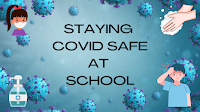School Stress During the Holiday Season
We love the holidays! But it is also a time when we do more.
We do more at home to prepare for the holidays and we do more at school.
The music teacher prepares specific grade levels for a Holiday
Music Program. The kids will need to spend some class time practicing beyond
the regular music class time. The art teacher has each grade level create
special art projects. You have your students making holiday gifts for their
parents. All this creates an additional exciting atmosphere throughout the
school for both teachers and students.
Hectic Schedule
Some school districts have parent conferences sometime in
November through December. This is a disruption to your schedule. Then there is
the Music Program to attend taking time away from your day. Your class must
attend the Art Project Display. So much going on! Oh well, just reconcile
yourself to the fact your daily routine will not be the same.
Frame of Mind
Be Extra Patient
Parents can be more demanding during this time. Carefully listen
to their concerns, acknowledge that you hear them, and let them know you will do
what you can.
The students will pick up on the extra energy going around.
Review your classroom expectations and rules to help remind them.
Staff members will also be feeling stressed. Share some kind
words with them. They will appreciate it.
Most of all, extend your patience with yourself. You are dealing
with all these things. Be kind to yourself!
Be Kind to Yourself
Plan for all the extra holiday
activities. Manage the shorter times with activities that can be done
before and after whole school programs.
Have alternate activities for the students who don’t celebrate
the holidays.
Learn to say No. Limit your commitments,
you don’t have to volunteer to do more than you are prepared to do.
Pace yourself. Give yourself extra quiet
time, prayer time, meditation, prep time, nap time, time for a walk, etcetera,
Gift Giving
Stay on budget. Decide who you want to
give gifts to. You don’t have to be Santa to everyone! I usually gave gifts to
the school secretary, the custodians, and the lunch ladies. You give so much of
yourself to your students that you don’t need to also give each of them a gift.
Reach Out to Your Support
Give a phone call to your bestie. Text a coworker. Talk to a
family member. Pull your spouse into it. You don’t have to do this by yourself.
But best of all, ENJOY THE HOLIDAYS!
Happy holidays!
Debbie – Froggy About Teaching





















































